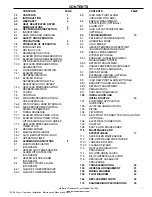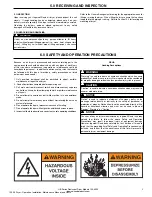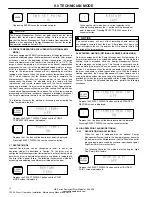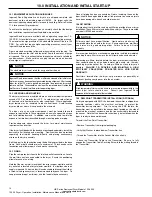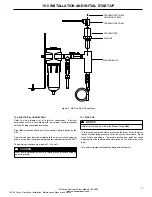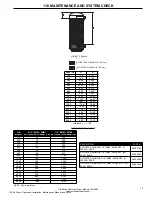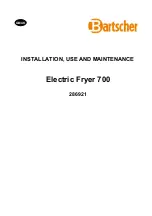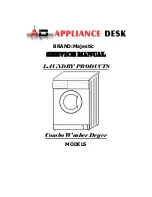
8
HB Series Desiccant Dryer Models 150-8000
ingersollrandproducts.com
8.1 MOISTURE INDICATOR (STANDARD)
The moisture indicator senses a sample of the control air which is taken
from the dryer outlet. The indicator provides a gross indication of dew
point deterioration at the outlet of the dryer. Under normal operating
conditions, the indicator is blue. In the event of a dryer malfunction or
prolonged dryer shut down, it will turn gray in the presence of moisture.
8.2 HEATER HIGH TEMPERATURE ALARM
WITH INTERLOCK (STANDARD)
The Heater High Temperature Alarm monitors the internal temperature
of the heater housing. Should a component failure occur or system
conditions result in the heater temperature rising above the alarm set
point, the dryer will alarm. During the alarm condition, the heater is
prevented from operating, the Microprocessor Control halts the program
at the point where the alarm occurred and displays the condition in the
Microprocessor Control LCD display. The dryer will be unable to be reset
until the temperature of the heater has fallen below the alarm point. To
reinstate the dryer, depress the RESET button on the Microprocessor
Controller AND manually reset the Heater High Temperature Safety in
the electrical enclosure. Note that the alarm condition will return should
proper corrective action not be taken.
8.3 HEATER FAILURE ALARM (STANDARD)
This feature produces an alarm should the heater fail to generate heat
at the beginning of the heating cycle. During the initial ten minutes of
the heating cycle, the Microprocessor Controller monitors the heater
temperature. Should the heater temperature fail to rise to 150 °F within
the ten minute period, the Heater Failure Alarm will be triggered. During
this alarm condition, power to the heater is removed and the program is
halted. Depressing the RESET button on the Microprocessor Controller
will reinstate the program and provided the heater problem has been
remedied, continue with normal operation.
8.4 FAILURE TO SHIFT ALARM (STANDARD)
Ingersoll Rand Failure To Shift Alarm monitors the dryer sequencing
functions to insure proper dryer operation by sensing the pressure in
each tower via tower pressure switches. Should one of the following
conditions occur, the Microprocessor Controller will communicate the
alarm condition. There are several types of switching failure modes that
can be detected by the Failure To Shift Alarm feature. They are as
follows:
8.4.1
FAILURE TO REPRESSURIZE
At the end of the repressurization stage of the dryer operation,
both towers should be at line pressure. Should the pressure
switches indicate that both towers are not at line pressure, the
Failure to Shift Alarm will activate and the Microprocessor
Control will stop the program at its current position in the
program. The user must depress the RESET button followed
by the ON button, at which time the Microprocessor Control
will start at the beginning of the program.
8.4.2
FAILURE TO DEPRESSURIZE
At the end of the depressurization stage of the dryer
operation, the regenerating tower should be at atmospheric
pressure. Should the pressure switches indicate that this is
not the case, the Failure to Shift Alarm will activate and the
Microprocessor Control will stop the program at its current
position in the program. The user must depress the RESET
button followed by the ON button, at which time the
Microprocessor Control will start at the beginning of the
program.
8.0 ALARMS AND INDICATORS
8.5 HIGH DEW POINT ALARM (INCLUDED WITH EMS)
The purpose of the High Dew Point Alarm is to provide the operator an
alarm indication should the equipment fail to supply air at its designed
pressure dew point. The EMS dew point sensor communicates the
pressure dew point reading to the Microprocessor Controller. Should
the pressure dew point rise above the alarm set point, the
Microprocessor Controller will display the alarm condition on the
controller screen.
8.6 ENERGY MANAGEMENT SYSTEM (EMS) (OPTIONAL)
EMS is an energy savings feature that matches moisture loading and
regeneration energy usage. Drying equipment is typically operated below
full flow rating and/or below maximum water loading capacity of the
desiccant bed. The EMS option includes a dew point transmitter that
transmits the outlet pressure dew point to the Microprocessor Controller.
The Microprocessor Controller displays the outlet pressure dew point in
real-time. The EMS feature utilizes the data communicated from the dew
point sensor and extends the normal timed switching sequence in
proportion to the moisture loading on the dryer. When the EMS feature is
turned off, all switching sequences occur as described in Section 7.7.
When the EMS feature is activated, the drying sequence is governed by
the outlet pressure dew point as measured by the dew point sensor. When
the sampled outlet dew point registers below the customer set point (-43°F
default for -40°F dryers; -102°F on -100°F dryers), an immediate change
in dryer operation will not be noticeable. The dryer will continue its normal
regeneration process through tower re-pressurization. Once the tower is
re-pressurized, both towers will be at line pressure but air will only flow
through the tower indicated by the status panel. Tower switch over
sequence is delayed until the dew point elevates above the EMS set point,
at which point tower switch over will occur.
In addition to monitoring the outlet pressure dew point of the drying
tower, the EMS feature monitors the temperature of the purge exhaust
air on the regenerating tower. After a tower switch-over, and at the
beginning of tower regeneration, the purge exhaust temperature will be
relatively low (normally 90 to 110°F). The purge exhaust temperature will
increase as desiccant regeneration progresses. As nearly all of the
previously adsorbed moisture is driven off of the desiccant, the exhaust
temperature will begin to rise. The timing for the temperature change will
vary depending on moisture loading on the towers. When the purge
exhaust temperature reaches 195°F, which indicates that the desiccant
heating is complete, the Microprocessor Controller will remove power to
the heater and subsequently the blower. If the Cool Sweep feature is
activated, the Cool Sweep runtime will commence. Otherwise, the offline
tower will repressurize and remain pressurized until tower switchover.
8.7 ALARM LIST
The Microprocessor Controller stores the 20 most recent alarm
conditions. These alarms are stored with the type of alarm as well as
the date and time the alarm occurred. This list can greatly facilitate
troubleshooting the dryer and provide an indication of dryer operation
during unattended service. The following describe the method to access
and review the alarms stored in the Microprocessor Controller:
Depress the SELECT DISPLAY button until the ALARM LIST
display appears.
ALARM LIST
PRESS ENTER
SELECT
DISPLAY
8.8 HIGH OUTLET TEMPERATURE (OPTIONAL)
This option provides continuous monitoring of the dryer discharge air
temperature via a thermostat that senses the outlet air temperature
during dryer operation. Should a high outlet temperature condition exist,
the alarm is displayed on the Microprocessor Controller to alert
maintenance personnel of a malfunction. This alarm does not interrupt
the dryer program. Depressing the RESET button will clear the alarm
provided the alarm condition has been addressed. Note that the alarm
will clear automatically once the high temperature condition is corrected.
120.26 Dryer - Operation, Installation, Maintenance Manual, and Parts



